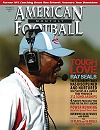AMERICAN FOOTBALL MONTHLY THE #1 RESOURCE FOR FOOTBALL COACHES
|
|
Article Categories
|
Speed Report – Quick Feet – A False Read for Speedby: Dale BaskettFootball Speed Specialist© More from this issueYes, a false read. The feet are not the focal point for speed and quickness or quick movement.
I install speed training programs in the football world year in and year out with coaches and players. Every time I go in with my football speed development training series, the subject of quick feet comes up. It is always the same – the realization that the foot is not where you should be looking to gain insight into real quickness, or its potential. Coaches commonly use the term good feet and foot speed as a descriptive indicator for speed and quickness. They often urge their athletes to move their feet faster. The feet become the focus point for the inducement of rapid limb speed but it is not the way to induce limb speed. It may seem like a logical assumption, but it is incorrect. Dynamic Limb Speed
Certain procedures mechan....The full article can only be seen by subscribers.
Subscribe today!

|
|
|
NOT A SUBSCRIBER?
Subscribe
now to start receiving our monthly magazine PLUS get INSTANT
unlimited access to over 4000 pages of 100 percent football coaching
information, ONLY available at AmericanFootballMonthly.com!
|
|
|
HOME
|
MAGAZINE
|
SUBSCRIBE
|
ONLINE COLUMNISTS
|
COACHING VIDEOS
|
Copyright 2025, AmericanFootballMonthly.com
All Rights Reserved






